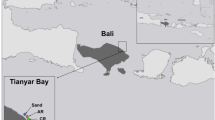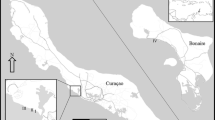Abstract
In many reef ecosystems, artificial reefs (AR) have become permanent additions to the area, sustaining well-developed benthic communities. Long-term studies on the development of AR coral communities are scarce, and comparisons with their natural surroundings are limited. The present study describes the stony and soft coral community structure of unplanned vertical AR in Eilat (Red Sea) that have progressed beyond the initial successional phases, and compares these to the adjacent natural reefs (NR). Coral communities were characterized using belt transects, conducted on 34- and 14-year-old unplanned AR, and on two proximate NR. Stony corals were the major component in the NR, while soft corals, mainly Nephtheidae, accounted for up to 90% of the total living coverage in the AR. This was attributed to physical and biological features associated with the AR’s vertical orientation, which was absent in the NR, and to the life history traits of these soft corals. Community differences between the two AR were related to structural stability and age. The results suggest that AR may increase local heterogeneity and space availability by adding novel habitats, increasing production and elevating species diversity in the surroundings.





Similar content being viewed by others
References
Aseltine-Neilson DA, Bernstein BB, Palmer-Zwahlen ML, Riege LE, Smith RW (1999) Comparisons of turf communities from Pendleton artificial reef, Torrey Pines artificial reef, and a natural reef using multivariate techniques. B Mar Sci 65(1):37–57
Baine M (2001) Artificial reefs: a review of their design, application, management and performance. Ocean Coast Manage 44:241–259
Baynes TW, Szmant AM (1989) Effect of current on the sessile benthic community structure of an artificial reef. B Mar Sci 44:545–566
Benayahu Y (1985) Faunistic composition and patterns in the distribution of soft corals (Octocorallia Alconacea) along the coral reefs of Sinai Peninsula. In: Richard G (ed) Proc 5th Int Coral Reef Symp, Tahiti, French Polynesia, 27 May–1 June 1985, 6:255–260
Benayahu Y, Loya Y (1977) Space partitioning by stony corals soft corals and benthic algae on the coral reefs of the northern Gulf of Eilat (Red Sea). Helgoland Wiss Meer 30:362–382
Benayahu Y, Loya Y (1987) Long-term recruitment of soft corals (Octocorallia: Alcyonacea) on artificial substrata at Eilat (Red Sea). Mar Ecol–Prog Ser 38:161–167
Bohnsack JA, Sutherland DL (1985) Artificial reef research: a review with recommendations for future priorities. B Mar Sci 37:11–39
Bohnsack JA, Ecklund AM, Szmant AM (1997) Artificial reef research: Is there more than the attraction-production issue? Fisheries 22:14–16
Bray JR, Curtis JT (1957) An ordination of the upland forest communities of southern Wisconsin. Ecol Monogr 27:325–349
Brown BE, Dunne RP, Goodson MS, Douglas AE (2000) Marine ecology: Bleaching patterns in reef corals. Nature 404:142–143
Carr MH, Hixon MA (1997) Artificial reefs: the importance of comparisons with natural reefs. Fisheries 22:28–33
Chou LM (1997) Artificial reefs of Southeast Asia – do they enhance or degrade the marine environment? Environ Monit Assess 44:45–52
Chou LM, Lim TM (1986) A preliminary study of the coral community on artificial and natural substrates. Malay Nat J 39:225–229
Clarke KR, Warwick RM (1994) Change in marine communities: an approach to statistical analysis and interpretations. National Environment Research Council, Swindon, UK
Clark S, Edwards AJ (1995) Coral transplantation as an aid to reef rehabilitation: Evaluation of a case study in the Maldive Islands. Coral Reefs 14:201–213
Clark S, Edwards AJ (1999) An evaluation of artificial reef structures as tools for marine habitat rehabilitation in the Maldives. Aquat Conserv 9:5–21
Dahan M, Benayahu Y (1997a) Reproduction of Dendronephthya hemprichi (Cnidaria: Octocorallia): year-round spawning in an azooxanthellate soft coral. Mar Biol 129:573–579
Dahan M, Benayahu Y (1997b) Clonal propagation by the azooxanthellate octocoral Dendronephthya hemprichi. Coral Reefs 16:5–12
Done TJ (1999) Coral community adaptability to environmental change at the scales of regions, reefs and reef zones. Am Zool 39:66–79
Fabricius KE, Genin A, Benayahu Y (1995) Flow-dependent herbivory and growth in zooxanthellae-free soft corals. Limnol Oceanogr 40:1290–1301
Fisk DA, Harriott VJ (1990) Spatial and temporal variation in coral recruitment on the Great Barrier Reef: implications for dispersal hypotheses. Mar Biol 107:485–490
Glasby TM (2001) Development of sessile marine assemblages on fixed versus moving substrata. Mar Ecol–Progr Ser 215:37–47
Goren R (1992) Benthic communities on artificial substrata at Eilat (Red Sea). MSc Thesis, Tel-Aviv University, Israel (Hebrew; English summary)
Grossman GD, Johnes GP, Seanan WJ (1997) Do artificial reefs increase regional fish production? A review of existing data. Fisheries 22:17–23
Hawkins JP, Roberts CM, Van’t Hof T, De Meyer K, Tratalos J, Aldam C (1999) Effects of recreational scuba diving on Caribbean coral and fish communities. Conserv Biol 13:888–897
Holloway MG, Connell DS (2002) Why do floating structures create novel habitats for subtidal epibiota? Mar Ecol–Prog Ser 235:43–52
Hughes TP, Connell JH (1999) Multiple stressors on coral reefs: a long term perspective. Limnol Oceanogr 44:932–940
Kuffner IB (2001) Effects of ultraviolet (UV) radiation on larval settlement of the reef coral Pocillopora damicornis. Mar Ecol–Prog Ser 217:251–261
Lambshead PJD, Platt HM, Shaw KM (1983) The detection of differences among assemblages of marine benthic species based on an assessment of dominance and diversity. J Nat Hist 17:859–874
Lasker HR, Coffroth MA (1999) Response of coral reef taxa to environmental change. Am Zool 39:92–103
Loya Y (1972) Community structure and species diversity of hermatipic corals at Eilat, Red Sea. Mar Biol 13:100–123
Lutzky S (1997) Reproductive strategies of two soft coral species: Scleronephthya corymbosa and Nephthea sp. MSc Thesis, Tel-Aviv University, Israel (Hebrew; English summary)
Mundy C, Babcock R (1998) Role of light intensity and spectral quality in coral settlement: implications for depth-dependant settlement. J Exp Mar Biol Ecol 223:235–255
Mundy C, Babcock R (2000) Are vertical distribution patterns of scleractinian corals maintained by pre- or post-settlement processes? A case study of three contrasting species. Mar Ecol–Prog Ser 198:109–119
Relini G, Relini M, Montanari M (2000) An offshore buoy as a small artificial island and a fish-aggregating device (FAD) in the Mediterranean. Hydrobiologia 440:65–80
Riegl B (1995) Effects of sand deposition on scleractinian and alcyonacean corals. Mar Biol 121:517–526
Rilov G, Benayahu Y (1998) Vertical artificial structures as an alternative habitat for coral reef fishes in disturbed environments. Mar Environ Res 45:431–451
Schuhmacher H (1974) On the conditions accompanying the first settlement of corals on artificial reefs with special reference to the influence of grazing sea urchins (Eilat, Red Sea). In: Cameron AM (ed) Proc 2nd Int Coral Reef Symp, Brisbane, Australia, October 1974, 1:257–267
Seaman W (2002) Unifying trends and opportunities in global artificial reef research, including evaluation. ICES J Mar Sci 59:S14-S16
Seaman W, Jensen AC (2000) Purposes and practices of artificial reef evaluation. In: Seaman W (ed) Artificial reef evaluation with application to natural marine habitats. CRC, Boca Raton, FL, pp 2–19
Shannon CE, Weaver W (1964) The mathematical theory of communication. University of Illinois Press, Urbarna, IL
Sokal RR, Rohlf FJ (1985) Biometry. Freeman and Co., San Francisco, CA
Svane IB, Petersen JK (2001) On the problems of epibiosis, fouling and artificial reefs, a review. PSZNI Mar Ecol 33:169–188
Weil D (1990) Life history of the alcyonacean Litophyton arboreum in the Gulf of Eilat: sexual and asexual reproduction. MSc Thesis, Tel-Aviv University, Israel (Hebrew; English summary)
Wendt PH, Knott DM, Van Dolah RF (1989) Community structure of the sessile biota on five artificial reefs of different ages. B Mar Sci 44:1106–1122
Wilhelmsson D, Ohman MC, Stahl H, Shlesinger Y (1998) Artificial reefs and dive tourism in Eilat, Israel. Ambio 27:764–766
Wilkinson CR (2000) Executive summary. In: Wilkinson CR (ed) Status of coral reefs of the world: 2000. Australian Institute of Marine Science, Townsville, Australia pp 7–19
Acknowledgements
We would like to thank the Interuniversity Institute of Eilat for its assistance and for making its facilities available to us. Dr. N. Shashar, G. Yahel, and T. Dagan are acknowledged for fruitful discussions and advice. We appreciate the critical comments of Prof. H. Lasker, Prof. R. Richmond, and of the anonymous reviewers, which greatly improved the quality of the manuscript. We acknowledge Eilat’s Naval Base authorities, the Dolphin Reef management, and the Israeli Nature and National Park Protection Authority for cooperation. We thank N. Paz for editorial assistance and V. Wexsler for graphical assistance. We also thank the Tel Aviv University Zoological Museum and Prof. Y. Loya for the use of the stony coral reference collection. The paper constitutes part of the Ms. Thesis submitted by S.P-F. This study was supported in part by a grant to Y.B. (# 6713–00) from the National Geographic Society.
Author information
Authors and Affiliations
Corresponding author
Additional information
Communicated by Biological Editor H.R. Lasker
Rights and permissions
About this article
Cite this article
Perkol-Finkel, S., Benayahu, Y. Community structure of stony and soft corals on vertical unplanned artificial reefs in Eilat (Red Sea): comparison to natural reefs. Coral Reefs 23, 195–205 (2004). https://doi.org/10.1007/s00338-004-0384-z
Received:
Accepted:
Published:
Issue Date:
DOI: https://doi.org/10.1007/s00338-004-0384-z




